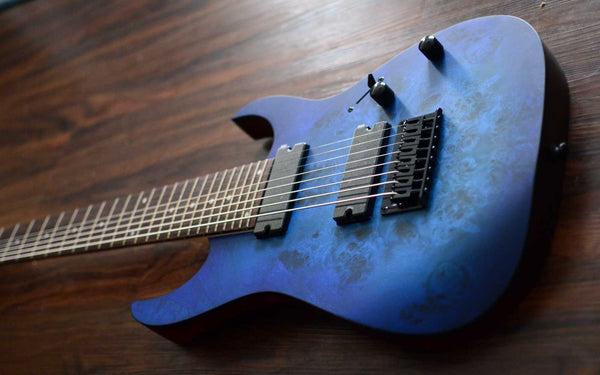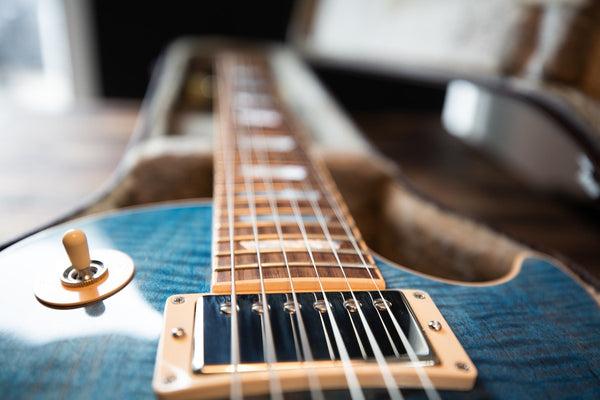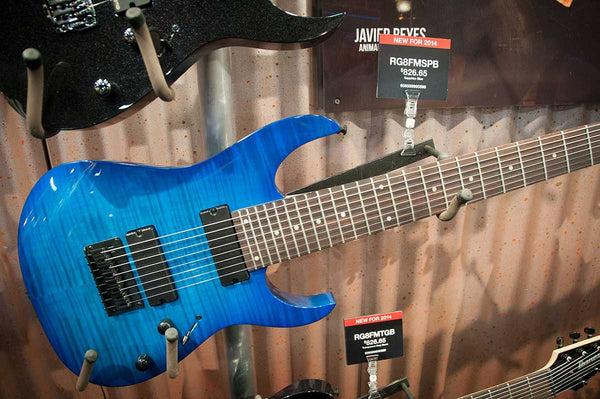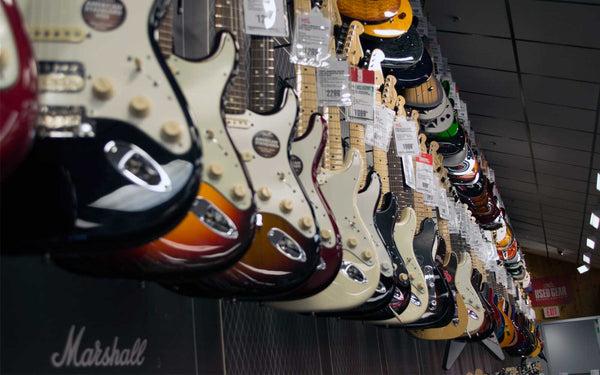If you’re new to the guitar & are wondering how many guitar strings it has or can have, stay tuned!
We’ll cover some of the most common string quantities out there regarding traditional & extended range instruments.
Plus, we’ll go over some pros & cons related to each type then answer some frequently asked questions.

Related: History of standard tuning
How many strings are in a Traditional Guitar?
Any modern guitar, whether acoustic or electric, typically has six guitar strings. These six strings come in a variety of thicknesses & this applies to both acoustic guitars & electric guitars.
Beginning from the thinnest string, the guitar strings are named string one, string two, and string three, and they go all the way up to the sixth string 6.
Typically the 3 thinnest strings are “plain”, with the 3 bottom strings being “wound” which make them significantly thicker. Sometimes the G string can be wound too.
Most guitars have their strings tuned to “standard” EADGBE tuning. With the low E string (thickest string) being closest to A, and the E closest to B being the thinnest string.
There’s also tunings such as drop D & many other alternate tunings available, but we won’t be going in depth on those in this particular article.

Related: Learn all 6 names for guitar strings
How Many Guitar Strings Are In An Extended Range Guitar?
Not all guitars have six strings however.
There are guitars that have seven or more strings which are known as extended-range guitars, ERG’s for short, or multi-scale guitars.
These seven, eight, nine, and sometimes ten string guitars have been increasingly popular over the past few years & are more widely available today.
These are unique instruments that not only have additional strings but also a longer scale length.
The biggest benefits are that they allow for a wider range of notes, increased versatility in playing complex chords, extended ranges, and alternate tunings.
Seven String
Seven string electric guitars follow the standard six-string tuning setup, but there is an additional B string.
The added B string is normally underneath the low E string & helps to beef up the sound of the instrument in general.
These guitars were popularized by bands such as Fear Factory, Korn, Meshuggah, Steve Vai, & Dream Theatre.
Related: How to tune a 7 string guitar
Eight String
Eight string guitars were once a more exotic or rare musical instruments but have also become readily available.
The 8 string tuning of this guitar is F#, B, E, A, D, G, B, E.
These instruments are typically used for metals where drop tuning is also a popular option.
Related: How to tune an 8 string guitar
Nine Strings Plus
A nine string guitar is still somewhat of a niche item but are widely available from many guitar manufacturers.
A few notable bands that use 9 string guitar are: After the burial, Animals as leaders, Rings of Saturn, Sleep, Deftones.
There’s also 10 & guitars with twelve strings, although the strings on these are usually doubled up into “courses” so essentially they are played like a 5 or six string guitar.
Related: How to tune a 9 string guitar

Pros and Cons of Six-String Guitars
This is your standard guitar & if you’re a beginner, you can’t go wrong with one of these!
Pros:
Ease of playing
Whether you go with acoustic or electric guitars, both are easier to pick up and learn versus choosing an extended range instrument.
A standard might be even easier to start, although those can still have their challenges with their more advanced playing techniques.
With a 6 string guitar there’s also countless resources since these instruments are most commonly played.
Versatility
The six string guitars are also versatile in that they’re not only available in acoustic or electric, but there’s also countless variations to choose from.
For example, there are Spanish guitars with nylon strings & acoustic dreadnoughts with steel strings – Both acoustic guitars.
In the electric side, you have single-coil stratocasters, Ibanez guitars with humbuckers, floating bridges, guitars with various configurations, and for a wide array of music genres.
Furthermore, you can find guitars that are smaller in size such as student guitars for smaller hands & aspiring young players.
Affordability
With the six string guitar being so abundant, there’s price points all across the board.
You can find a modern guitar as low as $100USD up to thousands of dollars for custom instruments.
It really comes down to your skill level & what price point you are comfortable with.

Cons:
Limiting To Some
Some prefer the exotic appeal of an extended range instrument, but this is mostly up to personal preference.
With a standard guitar you might not get the extra range, ability to play extra complex voicings, or wow factor that comes with a more unique instrument like a seven string guitar.
Bottom line however, is that there really isn’t much to gripe about with a standard guitar. So if you’re a new guitar player or looking to buy a guitar for someone, you won’t really go wrong with a regular guitar.
Pros and Cons of Extended Range Guitars
If you want to go beyond six strings, want lower notes, or exotic string configurations, then then an ERG might be for you.
Pros:
Wow Factor
Whether you go with seven string guitars or a nine string, you might get a lot of intrigue & people asking “how many that thing have?”
These instrument stand out & the more strings they have, the more they’re likely to turn heads.
There’s just something special out these instruments & that alone can make them desirable.
Unique Sound
These instruments also have a unique sound when compared to normal guitars such as punchy bass notes & powerful low end.
For this reason, they’re often used to play more aggressive styles of music such as Djent & Metal.
Extended Range
As the ERG name states, the biggest benefit of these instruments is the range.
With the added strings, you can explore more creative possibilities such as more complex guitar chords, voicings, & techniques.

Cons:
Availability
Unlike regular electric guitars which have hundreds of options out there, an ERG can bit a bit more difficult to come by.
They are more readily available now than in the past & you can get them at most major dealers, but only certain brands are willing to make them.
You’re not going to be able to go to the classic brands such as Fender or Gibson to buy one essentially.
Learning Curve
If 6 strings weren’t a challenge enough, dealing with up to 3 more strings can make some people’s head spin.
If you’re trying to learn music theory alongside your musical practices, this can also pose its own set of challenges such as with tuning & transposing music.
Finally, because these instruments are more niche, there isn’t as many resources to learn from.
Cost
Because an ERG is more of an advanced instrument & requires more resources to make, they are priced about double of what you would pay for a starter guitar.
This can deter newer players as the price price point is more along the lines of a mid-tier instrument.
Limited Use
Despite these guitars offering added versatility through more notes, they are typically only found in certain genres such as Djent, Jazz, & Metal.
If you play something else, you might not be able to make full use of the added range.
But then again, you could be the one to start something totally new!
Frequently Asked Questions

Can A Guitar Have 5 Strings?
There are “Baroque” guitars available with 10 gut strings, but they are in what’s called “courses” or sets. This means that they are basically played as a 5 stringed instrument.
Guitars with twelve strings also feature these courses & are played similarly to a 6 string guitar.
More common though, are electric bass guitars with 5 strings, which are extended range instruments, as typically have four strings.
Related: Picks vs Fingers For A Bass Player
What Are The 6 Guitar Strings?
The 6 strings for both electric guitar & acoustic guitar are E-A-D-G-B-E from lowest (thickest, last) to highest (thinnest & first string).
How Do You Remember The 6 Strings On A Guitar?
The best way to remember the six strings, is to remember an acronym.
You can use something like “Eating All Day Gets Boring Eventually” or “Every apple does good being eaten”
How Many Strings Does A Classical Guitar Have?
A classical or “Spanish” guitar uses nylon strings but it has the same amount as an acoustic or electric six string guitar, only the latter use metal strings.
How Many Strings Does A Bass Guitar Have?
electric bass guitars typically have four strings tuned similarly to a guitar but without the top 2 extra strings. The tuning on a standard bass guitar is E-A-D-G with the lowest string being E
Can Bass Guitars Have 5 or More Strings?
Yes there are extended range versions that have five strings with the fifth string being even lower than normal.
There’s also six string basses, but they’re tuned a bit differently than a guitar. Usually to B-E-A-D-G-C
Final Words
In this article, we discussed the amount of strings on a standard guitar (six strings) but also covered string instruments with an extended-range such as ERGs.
We also went over the pros & cons of each instrument if you’re considering buying either.
Finally we answered from frequently asked questions, so if you have any others to add, feel free to comment below.
Hopefully, this article will help you decide whether a traditional or an extended-range guitar is better for you!

